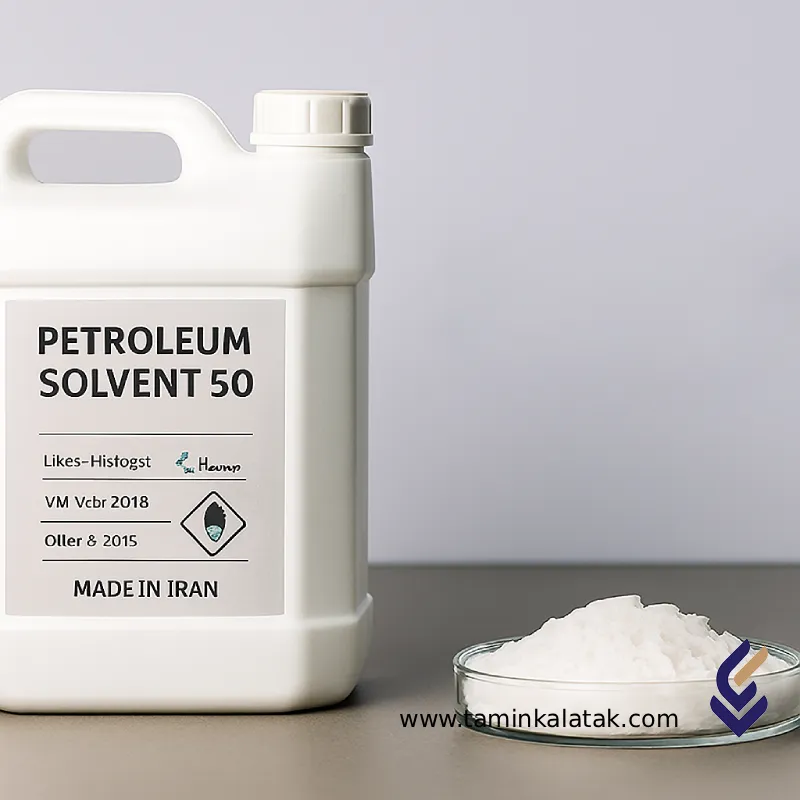Petroleum solvent 50
Petroleum Solvent 50 is one of the most important and widely used industrial solvents, utilized in various industries due to its special physical and chemical properties. This substance is composed of light petroleum hydrocarbons and is known as a medium-boiling point solvent. Petroleum Solvent 50 has extensive applications in paint manufacturing, chemical industries, cleaning, and adhesive production. It holds significant popularity in the industrial raw materials market due to its strong cleaning power and appropriate evaporation rate.
Chemical Structure of Petroleum Solvent 50
Petroleum Solvent 50 is a mixture of aliphatic and aromatic hydrocarbons with medium-length carbon chains. This solvent primarily consists of paraffins, naphthenes, and a certain amount of aromatics. It does not have a specific or unique chemical formula as it is a composite of several different hydrocarbons, but it can generally be described as a mixture of C7 to C12 hydrocarbons. The molecular structure of this solvent provides it with strong solvency for fats, resins, and paints, while also possessing a suitable evaporation rate.
Physical and Chemical Properties
- Appearance: Clear, colorless liquid
- Odor: Mild petroleum scent, not overly pungent
- Boiling Range: Approximately 140 to 220 °C (depending on the exact composition)
- Density: Approximately 0.75 to 0.80 g/cm³
- Solubility: Insoluble in water; a strong solvent for fats, resins, and many organic materials
- Flash Point: Approximately 40 to 60 °C
- Chemical Stability: Stable under normal conditions, but it is flammable and must be stored with caution.
Applications of Petroleum Solvent 50
Petroleum Solvent 50 is used in various industries due to its specific physical and chemical properties:
- Paint and Resin Industries: As a solvent for thinning paints, lacquers, and resins.
- Industrial Cleaning: For cleaning industrial parts and removing grease and oils.
- Adhesive Production: As a component in industrial adhesive formulations.
- Printing Industry: In printing processes and for thinning inks.
- Chemical Manufacturing: As a reaction solvent in the chemical and pharmaceutical industries.
- Automotive Industry: For cleaning parts and degreasing.
- Textile Industry: For thinning and cleaning dyes.
Disadvantages of Petroleum Solvent 50
- High Flammability: A significant drawback is the risk of fire and explosion under improper storage conditions.
- Health Hazards: Prolonged contact or inhalation of its vapors may cause respiratory system irritation, headaches, and nausea.
- Environmental Contamination: If released improperly, it can lead to the contamination of soil and water resources.
Advantages of Petroleum Solvent 50
- High Solvency Power: Capable of effectively dissolving various fats, resins, and paints.
- Controlled Evaporation: It has a slower evaporation rate than lighter solvents, which makes it easier to work with.
- Cost-Effective: It is more economical compared to similar solvents.
- Equipment Compatibility: Less likely to cause corrosion or damage to industrial tools.
- Wide Range of Use: Highly versatile in various industries due to its composite nature.
Safety and Storage of Petroleum Solvent 50
Adhering to the following points is essential for the safe use of Petroleum Solvent 50:
- Storage in a cool, dry place: Must be stored away from heat sources and open flames.
- Adequate Ventilation: The work environment must be well-ventilated to prevent the accumulation of vapors.
- Use of Protective Equipment: Such as gloves, safety goggles, and appropriate respirators to prevent direct contact and inhalation.
- Keep away from oxidizing agents: Contact with strong oxidizing materials must be avoided to reduce the risk of unwanted reactions.
- Proper Handling and Transport: Use standard, sealed containers resistant to leakage and evaporation.
Applications
| Applications | , , , |
|---|
Petroleum solvent 50
| Properties | Quantity / Description |
|---|---|
| Material type | Hydrocarbon cleaning fluid |
| Chemical family | Aliphatic and aromatic compounds |
| Product color | Colorless or slightly yellow |
| Fluorescence | Lower than gasoline and oil |
| Boiling point | About 130 to 220°C (depending on exact composition) |
| Solubility in water | Insoluble |
| Applications | Cleaning of oil equipment, oil platforms, petrochemical flooring, shipbuilding and isotanks |
| How to use | Pressure spray or direct pouring, then rinse with hot water |
| Safety | Use with mask and gloves recommended |
| Surface corrosion | Non-corrosive to metals, concrete, cement and stone |







